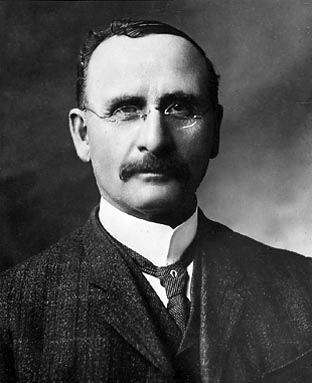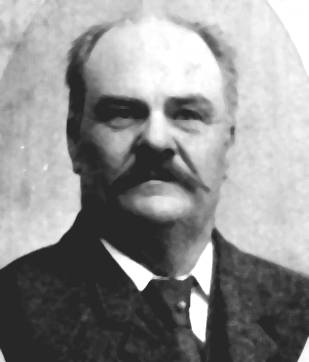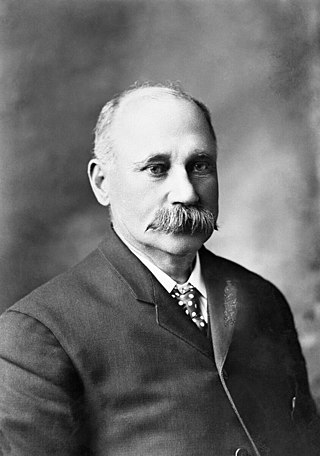
Alexander Cameron Rutherford was a Canadian lawyer and politician who served as the first premier of Alberta from 1905 to 1910. Born in Ormond, Canada West, he studied and practiced law in Ottawa before he moved with his family to the North-West Territories in 1895. Besides his work as lawyer, he began a political career that would see him first serve as member of the North-West Legislative Assembly and then as MLA and premier of Alberta. He lost the premiership in 1910 due to the Alberta and Great Waterways Railway scandal. He later was prominent in the administration of the University of Alberta, beside which his family lived for decades. His former home, Rutherford House is located on the grounds of the University of Alberta.

The University of Alberta is a public research university located in Edmonton, Alberta, Canada. It was founded in 1908 by Alexander Cameron Rutherford, the first premier of Alberta, and Henry Marshall Tory, the university's first president. It was enabled through the Post-secondary Learning Act. The university is considered a "comprehensive academic and research university" (CARU), which means that it offers a range of academic and professional programs that generally lead to undergraduate and graduate level credentials.

The 1905 Alberta general election was the first general election held in the Province of Alberta, Canada, shortly after the province entered Canadian Confederation on September 1, 1905. The election was held on November 9, 1905, to elect twenty-five members to the 1st Alberta Legislative Assembly.

The 1909 Alberta general election was the second general election held in the Province of Alberta, Canada. It took place on March 22, 1909, to elect 41 members to the 2nd Alberta Legislature. The incumbent Liberal Party led by Premier Alexander C. Rutherford achieved a re-election victory, securing a majority government by winning 36 out of the 41 seats in the legislature with just under 60 per cent of the popular vote. The Conservative Party led by Albert Robertson once again formed the official opposition, with only two members, and Robertson himself was defeated in his own seat in High River. The remaining three seats were divided among smaller parties and independent candidates.

William Henry Cushing was a Canadian politician. Born in Ontario, he migrated west as a young adult where he started a successful lumber company and later became Alberta's first Minister of Public Works and the 11th mayor of Calgary. As Minister of Public Works in the government of Alexander Cameron Rutherford, he oversaw the creation of Alberta Government Telephones.

Old Strathcona is a historic district in south-central Edmonton, Alberta, Canada. Once the commercial core of the separate city of Strathcona, the area is now home to many of Edmonton's arts and entertainment facilities, as well as a local shopping hub for residents and students at the nearby University of Alberta. The district centres on Whyte Avenue and has shops, restaurants, bars and buskers.
The Battle of Alberta is a term applied to the intense rivalry between the Canadian cities of Calgary, the province's most populous city, and Edmonton, the capital of the province of Alberta. Most often it is used to describe sporting events between the two cities, although this is not exclusive as the rivalry predates organized sports in Alberta.

Thomas Birkett was mayor of Ottawa, Ontario, Canada in 1891 and a member of the House of Commons of Canada representing Ottawa City from 1900 to 1904.
Albert Ludwig was a Canadian politician and World War II combat veteran, lawyer, judge and author from Alberta.

William Thomas Finlay was a merchant, politician and cabinet minister in Alberta and Northwest Territories, Canada. Finlay served as the second mayor of Medicine Hat, represented the electoral district of Medicine Hat in the Legislative Assembly of Alberta, and served in the Cabinet of Alexander Cameron Rutherford as Alberta's first Minister of Agriculture and Provincial Secretary from 1905 to 1909.
Strathcona was a city in Alberta, Canada on the south side of the North Saskatchewan River. Originally founded in 1891, it amalgamated with the City of Edmonton in 1912.

Rutherford Library is the first free-standing University of Alberta library, opened May 15, 1951, and named after the founder of the university, and long-time chancellor, Alexander Cameron Rutherford.
Mount Rutherford is a mountain in Jasper National Park in Alberta, Canada. It is part of the Northern Front Ranges of the Canadian Rockies. Its peak stands 3 km (2 mi) east of Harvey Lake and north of the Snaring River, a tributary of the Athabasca River.

Garneau is one of the oldest neighbourhoods in the city of Edmonton, Canada. Prior to 1912, it was part of the City of Strathcona. It is named after one of its first inhabitants, Laurent Garneau, a former Manitoba Métis rebel and Hudson's Bay Company employee who with his wife and family settled there around 1874.
Heritage buildings in Edmonton, as elsewhere in Canada, may be designated by any of the three levels of government: the Government of Canada, the Government of Alberta, or the City of Edmonton.
Frederick Charles Jamieson was a provincial politician, lawyer, and veteran from Alberta, Canada. He served as a member of the Legislative Assembly of Alberta from 1931 until 1935 sitting with the Conservative caucus in opposition. Jamieson was a veteran of the Second Boer War and the First World War and achieved the rank of Lieutenant Colonel. He died at age 91 on October 4, 1966.

The Princess Theatre is a two-screen art-house cinema located at 10337 Whyte Avenue in Edmonton's historic Old Strathcona neighbourhood. The building was designed by prominent Edmonton architects Wilson and Herrald, a firm responsible for the design of many other Edmonton heritage sites. It became Edmonton's oldest surviving theatre after the demolition of the Gem Theatre in 2006. The building currently houses the main 400-seat theatre as well as the 100-seat Princess II, located in the basement.

The Rutherford Ministry was the combined Cabinet, chaired by Premier Alexander Cameron Rutherford, and Ministers that governed Alberta from the day following the province's Confederation into Canada on September 2, 1905, to part way through the 2nd Alberta Legislature on May 26, 1910.












